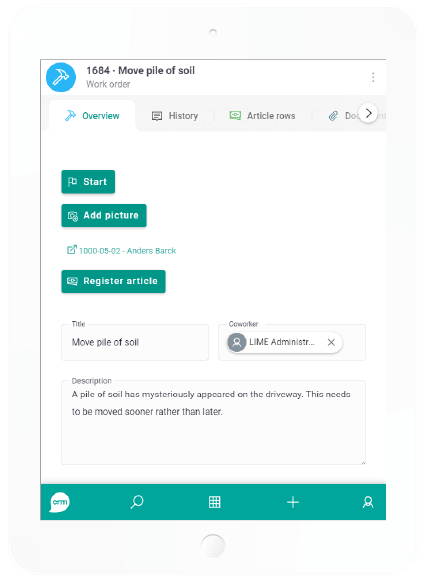Three ways to work smarter with work order management

In many industries, such as real estate, machinery, and energy, work order management is part of the everyday operation. Work order management plays an important part in explaining which tasks are on the agenda, identifying responsible parties, defining timelines, and providing guidelines on how to accomplish the tasks. Whether it’s a work order for inspection of a critical piece of machinery or a property manager grappling with an incoming error report, having seamless access to information becomes an important part of executing the tasks at hand in a fast and efficient manner.
In response to the challenges of traditional work order management, with its complicated paperwork and inefficient resource allocation, an increasingly number of businesses are transitioning to using digital work order management instead. No more is there a need for pen and paper or Excel-based systems to keep track of things, which can lead to critical information getting lost in transit. In a modern work environment, work order management is no longer just about making sure tasks are completed, it’s evolved into a strategic tool for strengthening collaboration between the office and the field work, helping to create a better customer experience.
Let’s take a closer look at what digital work order management is, and highlight three ways it can add value for businesses and their customers.
Do you want to know more about digital work order management and how it works in a CRM system?
What does digital work order management mean?
A work order should include all the parts of a task that needs to be completed. The term work order is commonly used across a range of industries such as real estate, machinery services, and energy, and typically applies to activities such as repairs, maintenance, or installations. The problem usually lies in how this kind of work process is handled, and that’s where work order management steps in. Traditionally a supervisor makes sure the work order has all the required information, such as: what needs to be accomplished, the materials required, the deadline of the work order, and the assigned personnel. In cases where the task at hand demands also needs specific safety protocols, this information becomes part of the work order too.
Once the work order is prepared and ready it’s assigned to the field worker responsible for carrying out the work. This is where digital work order management enters, a modern solution that centralises this entire process in a singular system, where all the important information is seamlessly organised. The beauty of digital work order management lies in its accessibility, you can easily access it no matter if you’re using a computer, tablets or mobile phone. Digital work orders has a lot of advantages compared to the old ways of doing it with it’s user-friendly interface and the ability to update information instantly.
Having good work order management enables your business to create an organised and more efficient workflow that encourages greater collaboration between the office and the field.
Want to know more about improving field service management?
Three ways to create added value through digital work order management
Let’s look into three ways digital work orders helps businesses create a better customer experience:
Uninterrupted access to information
One of the risks of inadequate work order processing is that it can result in internal information islands. There’s nothing worse than when the field service technician receives a stack of papers with work orders and finds out that crucial information is missing to solve the task at hand. Or a customer calling in for information updates about their issue, only to get stuck in an eternal loop between customer service and technician. Digital work order management serves as a solution to these kinds of information discrepancies. Using digital work orders both supervisors and field workers can make sure that all the required information is always available, creating real-time visibility of important information for all the involved parties. This doesn’t only create smoother communication and feedback to customers but also helps field workers with getting clear instructions and providing supervisors with a comprehensive overview of what’s happening.
A better customer experience
In an age where technological advancements reshape customers expectations, the standard of what good service is evolves over time. Customers now demand quicker service, real-time status updates, and the ability to choose the delivery of services. Adapting to these changing expectations is critical for businesses aiming to not only meet but exceed their customer expectations. By raising the quality of each work order and ensuring that resources are used optimally, the workflow becomes significantly more productive and efficient. Customers can get help faster and enjoy a better and more professional service experience. By showing your customers you actually care about their experience, by for instance making sure they receive ongoing status updates, you’ll create a better customer experience that will lead to happier customers.
Be proactive when making decisions
A unified digital system for work orders enables the ability to make more informed decisions, shifting from taking decisions on a gut feeling, to doing it data-driven instead. With all the information consolidated in one system, patterns and trends become easier to see. Is there a recurring issue at a property south of the river? Which jobs demand more time on the field, and which resources outperform in specific areas?
Having control over the entire workflow enables proactive decision-making. Automation can become a strategic tool that can generate work orders for routine tasks and incorporating quality maintenance through for example checklists. Integration with a Customer Relationship Management (CRM) systems elevates the game further, providing a holistic view of all the customer information and a comprehensive history of past issues. This not only enhances operational efficiency but positions businesses to respond swiftly to the customers evolving needs, making sure resources are deployed where they are mostly needed.
Learn more about work order management
In conclusion
Digital work order management not only helps businesses to create higher quality work orders, but also improves the link between supervisors, field workers and the customers. With more efficient resource planning and all the information available in one system, resources can be used in a better way. This not only saves both time and money but also helps you deliver a great customer care to your customers along the way.

Lime Work Order is the best of both worlds – the strength and flexibility of Lime CRM, combined with work order management for seamless flows. All in one system to simplify your everyday life. Do you want to know more?
Want smarter work order handling?
There’s no time to waste! Let’s find the solution that will help you get more customers and turn existing ones into loyal ambassadors today.